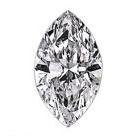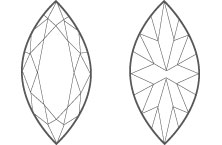Marquise Shape
 The Marquise cut (pronounced ‘mar-KEYS’) makes for a dramatic centrepiece to a ring, which, like the other longer shapes, creates a favourable illusion of elongating the finger. However, set horizontally across the finger, it can create a striking look because of its eye shape.
The Marquise cut (pronounced ‘mar-KEYS’) makes for a dramatic centrepiece to a ring, which, like the other longer shapes, creates a favourable illusion of elongating the finger. However, set horizontally across the finger, it can create a striking look because of its eye shape.
Facet Pattern
The Marquise is usually cut as an adaption of the 58-facet Brilliant shape, with 33 facets on the crown and 25 on the pavilion. However, the pavilion can be cut with either 4, 6 or 8 pavilion main facets, depending on the stone’s girdle outline (as can the pear, oval and heart shaped cuts).
The crown is also sometimes modified in the Marquise to form a ‘French tip’ where the bezel facet at the point of the stone is eliminated. French tips are also sometimes cut in pear and heart shaped diamonds.
The length to width ration is an important aspect to the stone’s appearance in all cuts and for the Marquise, the preferred range is 1.75-2.25 : 1.00. Marquise diamonds frequently show a box tie, so it is important to view a selection of diamonds when choosing one for a piece of jewellery so you can select one where this effect is minimal or absent.
History
The Marquise cut can trace its history back to the height of the French monarchy. King Louis XV commissioned his jeweller to devise a diamond whose shape mirrored the smile of his beautiful mistress.
